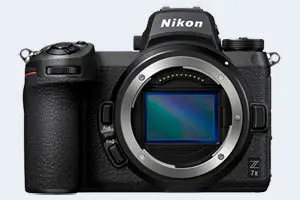Nikon 1 J4 vs Z7 II
The Nikon 1 J4 and the Nikon Z7 II are two digital cameras that were announced, respectively, in April 2014 and October 2020. Both the J4 and the Z7 II are mirrorless interchangeable lens cameras that are based on an one-inch (J4) and a full frame (Z7 II) sensor. The J4 has a resolution of 18.2 megapixels, whereas the Z7 II provides 45.4 MP.
Below is an overview of the main specs of the two cameras as a starting point for the comparison.

Check J4 offers at
ebay.com

Check Z7 II price at
amazon.com
Going beyond this snapshot of core features and characteristics, what are the differences between the Nikon 1 J4 and the Nikon Z7 II? Which one should you buy? Read on to find out how these two cameras compare with respect to their body size, their imaging sensors, their shooting features, their input-output connections, and their reception by expert reviewers.
Body comparison
The physical size and weight of the Nikon 1 J4 and the Nikon Z7 II are illustrated in the side-by-side display below. The two cameras are presented according to their relative size. Three consecutive views from the front, the top, and the rear side are shown. All size dimensions are rounded to the nearest millimeter.
The J4 can be obtained in four different colors (black, silver, orange, white), while the Z7 II is only available in black.
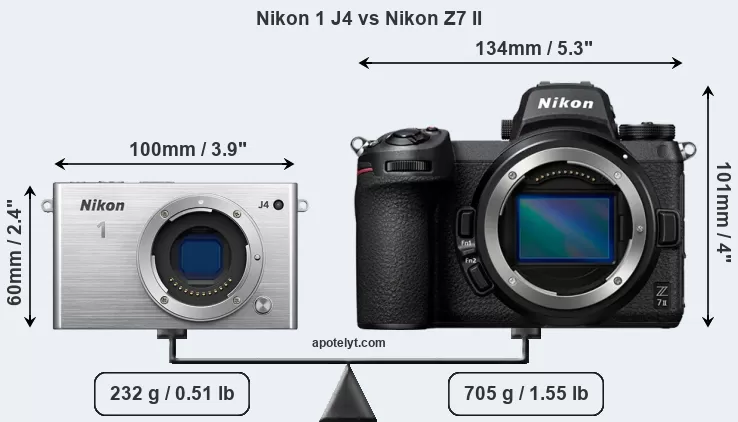
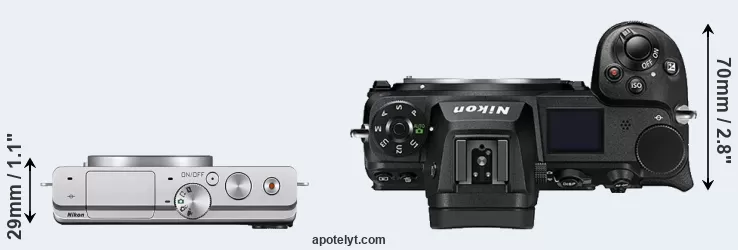
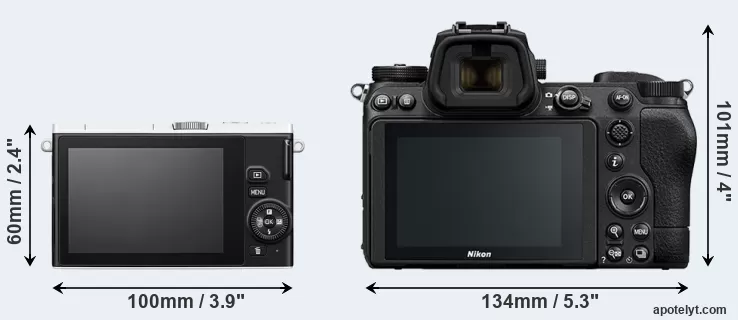
If the front view area (width x height) of the cameras is taken as an aggregate measure of their size, the Nikon Z7 II is considerably larger (126 percent) than the Nikon 1 J4. Moreover, the Z7 II is substantially heavier (204 percent) than the J4. It is noteworthy in this context that the Z7 II is splash and dust-proof, while the J4 does not feature any corresponding weather-sealing.
The above size and weight comparisons are to some extent incomplete since they do not consider the interchangeable lenses that both of these cameras require. Hence, you might want to study and compare the specifications of available lenses in order to get the full picture of the size and weight of the two camera systems.
The power pack in the Z7 II can be charged via the USB port, which can be very convenient when travelling.
The following table provides a synthesis of the main physical specifications of the two cameras and other similar ones. If you would like to visualize and compare a different camera combination, you can navigate to the CAM-parator app and make your selection from a broad list of cameras there.

| Camera Model |
Camera Width |
Camera Height |
Camera Depth |
Camera Weight |
Battery Life |
Weather Sealing |
Camera Launch |
Launch Price (USD) |
Street Price |
||
|---|---|---|---|---|---|---|---|---|---|---|---|
| 1. | Nikon 1 J4 | 100 mm | 60 mm | 29 mm | 232 g | 300 | n | Apr 2014 | 549 | ebay.com | |
| 2. | Nikon Z7 II | 134 mm | 101 mm | 70 mm | 705 g | 420 | Y | Oct 2020 | 2,999 | amazon.com | |
| 3. | Canon G9 X | 98 mm | 58 mm | 31 mm | 209 g | 220 | n | Oct 2015 | 529 | ebay.com | |
| 4. | Canon G9 X Mark II | 98 mm | 58 mm | 31 mm | 206 g | 235 | n | Jan 2017 | 529 | ebay.com | |
| 5. | Canon SL1 | 117 mm | 91 mm | 69 mm | 407 g | 380 | n | Mar 2013 | 549 | ebay.com | |
| 6. | Nikon 1 J5 | 98 mm | 60 mm | 32 mm | 231 g | 250 | n | Apr 2015 | 399 | ebay.com | |
| 7. | Nikon 1 V2 | 109 mm | 82 mm | 46 mm | 278 g | 310 | n | Oct 2012 | 799 | ebay.com | |
| 8. | Nikon 1 V3 | 111 mm | 65 mm | 33 mm | 381 g | 310 | n | Mar 2014 | 799 | ebay.com | |
| 9. | Nikon P900 | 140 mm | 103 mm | 137 mm | 899 g | 360 | n | Mar 2015 | 599 | ebay.com | |
| 10. | Nikon Z6 II | 134 mm | 101 mm | 70 mm | 705 g | 410 | Y | Oct 2020 | 1,999 | amazon.com | |
| 11. | Nikon Z7 | 134 mm | 101 mm | 67 mm | 675 g | 330 | Y | Aug 2018 | 3,399 | ebay.com | |
| 12. | Nikon Z9 | 149 mm | 150 mm | 91 mm | 1340 g | 740 | Y | Oct 2021 | 5,499 | amazon.com | |
| 13. | Panasonic FZ1000 | 137 mm | 99 mm | 131 mm | 831 g | 360 | n | Jun 2014 | 899 | ebay.com | |
| 14. | Panasonic G6 | 122 mm | 85 mm | 71 mm | 390 g | 340 | n | Apr 2013 | 599 | ebay.com | |
| 15. | Panasonic GF7 | 107 mm | 65 mm | 33 mm | 266 g | 230 | n | Jan 2015 | 499 | ebay.com | |
| 16. | Sony A7R II | 127 mm | 96 mm | 60 mm | 625 g | 290 | Y | Jun 2015 | 3,199 | ebay.com | |
| 17. | Sony A7R IIIA | 127 mm | 96 mm | 74 mm | 650 g | 650 | Y | Apr 2021 | 3,199 | amazon.com | |
| Note: Measurements and pricing do not include easily detachable parts, such as add-on or interchangeable lenses or optional viewfinders. | |||||||||||
Any camera decision will obviously take relative prices into account. The listed launch prices provide an indication of the market segment that the manufacturer of the cameras have been targeting. The J4 was launched at a markedly lower price (by 82 percent) than the Z7 II, which puts it into a different market segment. Usually, retail prices stay at first close to the launch price, but after several months, discounts become available. Later in the product cycle and, in particular, when the replacement model is about to appear, further discounting and stock clearance sales often push the camera price considerably down. Then, after the new model is out, very good deals can frequently be found on the pre-owned market.
Sensor comparison
The size of the imaging sensor is a crucial determinant of image quality. All other things equal, a large sensor will have larger individual pixel-units that offer better low-light sensitivity, wider dynamic range, and richer color-depth than smaller pixels in a sensor of the same technological generation. Furthermore, a large sensor camera will give the photographer more possibilities to use shallow depth-of-field in order to isolate a subject from the background. On the downside, larger sensors are more costly to manufacture and tend to lead to bigger and heavier cameras and lenses.
Of the two cameras under consideration, the Nikon 1 J4 features an one-inch sensor and the Nikon Z7 II a full frame sensor. The sensor area in the Z7 II is 640 percent bigger. As a result of these sensor size differences, the cameras have a format factor of, respectively, 2.7 and 1.0. Both cameras have a native aspect ratio (sensor width to sensor height) of 3:2.
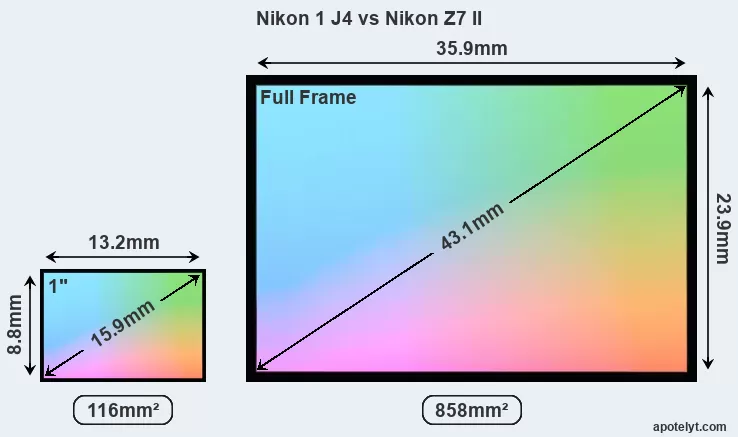
With 45.4MP, the Z7 II offers a higher resolution than the J4 (18.2MP), but the Z7 II nevertheless has larger individual pixels (pixel pitch of 4.35μm versus 2.52μm for the J4) due to its larger sensor. Moreover, the Z7 II is a much more recent model (by 6 years and 6 months) than the J4, and its sensor will have benefitted from technological advances during this time that further enhance the light gathering capacity of its pixel-units. Coming back to sensor resolution, it should be mentioned that neither of the two cameras has an anti-alias filter installed, so they are able to capture all the detail the sensor resolves.
The resolution advantage of the Nikon Z7 II implies greater flexibility for cropping images or the possibility to print larger pictures. The maximum print size of the Z7 II for good quality output (200 dots per inch) amounts to 41.3 x 27.5 inches or 104.9 x 69.9 cm, for very good quality (250 dpi) 33 x 22 inches or 83.9 x 55.9 cm, and for excellent quality (300 dpi) 27.5 x 18.3 inches or 69.9 x 46.6 cm. The corresponding values for the Nikon 1 J4 are 26.2 x 17.4 inches or 66.4 x 44.3 cm for good quality, 20.9 x 14 inches or 53.2 x 35.4 cm for very good quality, and 17.4 x 11.6 inches or 44.3 x 29.5 cm for excellent quality prints.
The Nikon 1 J4 has a native sensitivity range from ISO 160 to ISO 12800. The corresponding ISO settings for the Nikon Z7 II are ISO 64 to ISO 25600, with the possibility to increase the ISO range to 32-102400.
In terms of underlying technology, the J4 is build around a CMOS sensor, while the Z7 II uses a BSI-CMOS imager. Both cameras use a Bayer filter for capturing RGB colors on a square grid of photosensors. This arrangement is found in most digital cameras.
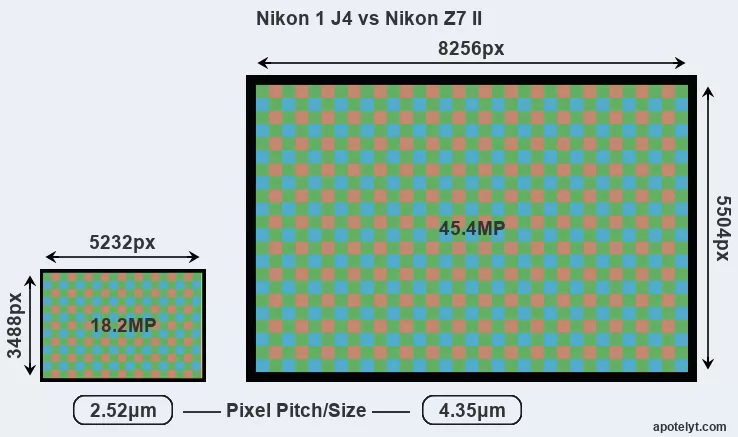
Since 2007, DXO Mark has published sensor performance measurements that have been derived using a consistent methodology. This service determines an overall sensor rating, as well as sub-scores for low-light sensitivity ("DXO Sports"), dynamic range ("DXO Landscape"), and color depth ("DXO Portrait"). Of the two cameras under consideration, the Z7 II offers substantially better image quality than the J4 (overall score 47 points higher). The advantage is based on 5.5 bits higher color depth, 4 EV in additional dynamic range, and 2.7 stops in additional low light sensitivity. The table below summarizes the physical sensor characteristics and sensor quality findings and compares them across a set of similar cameras.

| Camera Model |
Sensor Class |
Resolution (MP) |
Horiz. Pixels |
Vert. Pixels |
Video Format |
DXO Portrait |
DXO Landscape |
DXO Sports |
DXO Overall |
||
|---|---|---|---|---|---|---|---|---|---|---|---|
| 1. | Nikon 1 J4 | 1-inch | 18.2 | 5232 | 3488 | 1080/60p | 20.8 | 10.7 | 426 | 53 | |
| 2. | Nikon Z7 II | Full Frame | 45.4 | 8256 | 5504 | 4K/60p | 26.3 | 14.7 | 2841 | 100 | |
| 3. | Canon G9 X | 1-inch | 20.0 | 5472 | 3648 | 1080/60p | 21.5 | 12.3 | 495 | 63 | |
| 4. | Canon G9 X Mark II | 1-inch | 20.0 | 5472 | 3648 | 1080/60p | 21.9 | 12.5 | 522 | 65 | |
| 5. | Canon SL1 | APS-C | 17.9 | 5184 | 3456 | 1080/30p | 21.8 | 11.3 | 843 | 63 | |
| 6. | Nikon 1 J5 | 1-inch | 20.7 | 5568 | 3712 | 4K/15p | 21.1 | 12.0 | 479 | 65 | |
| 7. | Nikon 1 V2 | 1-inch | 14.2 | 4608 | 3072 | 1080/60p | 20.2 | 10.8 | 403 | 50 | |
| 8. | Nikon 1 V3 | 1-inch | 18.2 | 5232 | 3488 | 1080/60p | 20.8 | 10.7 | 384 | 52 | |
| 9. | Nikon P900 | 1/2.3 | 15.9 | 4608 | 3456 | 1080/60p | 20.2 | 11.6 | 727 | 47 | |
| 10. | Nikon Z6 II | Full Frame | 24.3 | 6048 | 4024 | 4K/60p | 25.0 | 14.4 | 3303 | 94 | |
| 11. | Nikon Z7 | Full Frame | 45.4 | 8256 | 5504 | 4K/30p | 26.3 | 14.6 | 2668 | 99 | |
| 12. | Nikon Z9 | Full Frame | 45.4 | 8256 | 5504 | 8K/30p | 26.3 | 14.4 | 2451 | 98 | |
| 13. | Panasonic FZ1000 | 1-inch | 20.0 | 5472 | 3648 | 4K/30p | 22.1 | 11.7 | 517 | 64 | |
| 14. | Panasonic G6 | Four Thirds | 15.9 | 4608 | 3456 | 1080/60p | 21.3 | 11.5 | 639 | 61 | |
| 15. | Panasonic GF7 | Four Thirds | 15.8 | 4592 | 3448 | 1080/60p | 22.7 | 12.3 | 874 | 70 | |
| 16. | Sony A7R II | Full Frame | 42.2 | 7952 | 5304 | 4K/30p | 26.0 | 13.9 | 3434 | 98 | |
| 17. | Sony A7R IIIA | Full Frame | 42.2 | 7952 | 5304 | 4K/30p | 26.0 | 14.7 | 3523 | 100 | |
| Note: DXO values in italics represent estimates based on sensor size and age. | |||||||||||
Many modern cameras cannot only take still pictures, but also record videos. Both cameras under consideration are equipped with sensors that have a sufficiently high read-out speed for moving images, but the Z7 II provides a better video resolution than the J4. It can shoot movie footage at 4K/60p, while the J4 is limited to 1080/60p.
Feature comparison
Beyond body and sensor, cameras can and do differ across a range of features. For example, the Z7 II has an electronic viewfinder (3690k dots), which can be very helpful when shooting in bright sunlight. In contrast, the J4 relies on live view and the rear LCD for framing. The adjacent table lists some of the other core features of the Nikon 1 J4 and Nikon Z7 II along with similar information for a selection of comparators.

| Camera Model |
Viewfinder (Type or 000 dots) |
Control Panel (yes/no) |
LCD Specifications (inch/000 dots) |
LCD Attach- ment |
Touch Screen (yes/no) |
Max Shutter Speed * |
Max Shutter Flaps * |
Built-in Flash (yes/no) |
Built-in Image Stab |
||
|---|---|---|---|---|---|---|---|---|---|---|---|
| 1. | Nikon 1 J4 | none | n | 3.0 / 1037 | Fixed | Y | 1/4000s | 60.0/s | Y | n | |
| 2. | Nikon Z7 II | 3690 | Y | 3.2 / 2100 | tilting | Y | 1/8000s | 10.0/s | n | Y | |
| 3. | Canon G9 X | none | n | 3.0 / 1040 | fixed | Y | 1/2000s | 6.0/s | Y | Y | |
| 4. | Canon G9 X Mark II | none | n | 3.0 / 1040 | fixed | Y | 1/2000s | 8.2/s | Y | Y | |
| 5. | Canon SL1 | optical | n | 3.0 / 1040 | fixed | Y | 1/4000s | 4.9/s | Y | n | |
| 6. | Nikon 1 J5 | none | n | 3.0 / 1037 | tilting | Y | 1/4000s | 60.0/s | Y | n | |
| 7. | Nikon 1 V2 | 1440 | n | 3.0 / 921 | fixed | n | 1/4000s | 15.0/s | Y | n | |
| 8. | Nikon 1 V3 | optional | n | 3.0 / 1037 | tilting | Y | 1/4000s | 60.0/s | Y | n | |
| 9. | Nikon P900 | 921 | n | 3.0 / 921 | swivel | n | 1/4000s | 7.0/s | Y | Y | |
| 10. | Nikon Z6 II | 3690 | Y | 3.2 / 2100 | tilting | Y | 1/8000s | 14.0/s | n | Y | |
| 11. | Nikon Z7 | 3690 | Y | 3.2 / 2100 | tilting | Y | 1/8000s | 9.0/s | n | Y | |
| 12. | Nikon Z9 | 3690 | Y | 3.2 / 2089 | full-flex | Y | 1/32000s | 30.0/s | n | Y | |
| 13. | Panasonic FZ1000 | 2359 | n | 3.0 / 921 | swivel | n | 1/4000s | 12.0/s | Y | Y | |
| 14. | Panasonic G6 | 1440 | n | 3.0 / 1036 | swivel | Y | 1/4000s | 7.0/s | Y | n | |
| 15. | Panasonic GF7 | none | n | 3.0 / 1040 | tilting | Y | 1/500s | 5.8/s | Y | n | |
| 16. | Sony A7R II | 2400 | n | 3.0 / 1229 | tilting | n | 1/8000s | 5.0/s | n | Y | |
| 17. | Sony A7R IIIA | 3686 | n | 3.0 / 2340 | tilting | Y | 1/8000s | 10.0/s | n | Y | |
| Note: *) Information refers to the mechanical shutter, unless the camera only has an electronic one. | |||||||||||
One difference between the cameras concerns the presence of an on-board flash. The J4 has one, while the Z7 II does not. While the built-in flash of the J4 is not very powerful, it can at times be useful as a fill-in light.
The reported shutter speed information refers to the use of the mechanical shutter. Yet, some cameras only have an electronic shutter, while others have an electronic shutter in addition to a mechanical one. In fact, both cameras under consideration feature an electronic shutter, which makes completely silent shooting possible. However, this mode is less suitable for photographing moving objects (risk of rolling shutter) or shooting under artificial light sources (risk of flickering).
The Nikon Z7 II has an intervalometer built-in. This enables the photographer to capture time lapse sequences, such as flower blooming, a sunset or moon rise, without purchasing an external camera trigger and related software.
The J4 writes its imaging data to micro SDXC cards, while the Z7 II uses CFexpress (type B) or SDXC cards. The Z7 II features dual card slots, which can be very useful in case a memory card fails. In contrast, the J4 only has one slot. The Z7 II supports UHS-II cards (Ultra High Speed data transfer of up to 312 MB/s), while the J4 can use UHS-I cards (up to 104 MB/s).
Connectivity comparison
For some imaging applications, the extent to which a camera can communicate with its environment can be an important aspect in the camera decision process. The table below provides an overview of the connectivity of the Nikon 1 J4 and Nikon Z7 II and, in particular, the interfaces the cameras (and selected comparators) provide for accessory control and data transfer.

| Camera Model |
Hotshoe Port |
Internal Mic / Speaker |
Microphone Port |
Headphone Port |
HDMI Port |
USB Port |
WiFi Support |
NFC Support |
Bluetooth Support |
||
|---|---|---|---|---|---|---|---|---|---|---|---|
| 1. | Nikon 1 J4 | - | stereo / mono | - | - | mini | 2.0 | Y | - | - | |
| 2. | Nikon Z7 II | Y | stereo / mono | Y | Y | micro | 3.2 | Y | - | Y | |
| 3. | Canon G9 X | - | stereo / mono | - | - | micro | 2.0 | Y | Y | - | |
| 4. | Canon G9 X Mark II | - | stereo / mono | - | - | micro | 2.0 | Y | Y | Y | |
| 5. | Canon SL1 | Y | mono / mono | Y | - | mini | 2.0 | - | - | - | |
| 6. | Nikon 1 J5 | - | stereo / mono | - | - | micro | 2.0 | Y | Y | - | |
| 7. | Nikon 1 V2 | - | stereo / mono | - | - | mini | 2.0 | - | - | - | |
| 8. | Nikon 1 V3 | - | stereo / mono | Y | - | mini | 2.0 | Y | - | - | |
| 9. | Nikon P900 | - | stereo / mono | - | - | micro | 2.0 | Y | Y | - | |
| 10. | Nikon Z6 II | Y | stereo / mono | Y | Y | micro | 3.2 | Y | - | Y | |
| 11. | Nikon Z7 | Y | stereo / mono | Y | Y | micro | 3.1 | Y | - | Y | |
| 12. | Nikon Z9 | Y | stereo / mono | Y | Y | full | 3.2 | Y | - | Y | |
| 13. | Panasonic FZ1000 | Y | stereo / mono | Y | - | micro | 2.0 | Y | Y | - | |
| 14. | Panasonic G6 | Y | stereo / mono | Y | - | mini | 2.0 | Y | Y | - | |
| 15. | Panasonic GF7 | - | stereo / mono | - | - | micro | 2.0 | Y | Y | - | |
| 16. | Sony A7R II | Y | stereo / mono | Y | Y | micro | 2.0 | Y | Y | - | |
| 17. | Sony A7R IIIA | Y | stereo / mono | Y | Y | micro | 3.2 | Y | Y | Y |
It is notable that the Z7 II has a headphone jack, which makes it possible to attach external headphones and monitor the quality of sound during the recording process. The J4 lacks such a headphone port.
The Z7 II is a recent model that features in the current product line-up of Nikon. In contrast, the J4 has been discontinued (but can be found pre-owned on ebay). As a replacement in the same line of cameras, the J4 was succeeded by the Nikon 1 J5. Further information on the features and operation of the J4 and Z7 II can be found, respectively, in the Nikon 1 J4 Manual (free pdf) or the online Nikon Z7 II Manual.
Review summary
So what is the bottom line? Is the Nikon 1 J4 better than the Nikon Z7 II or vice versa? A synthesis of the relative strong points of each of the models is listed below.
Advantages of the Nikon 1 J4:
- Faster burst: Shoots at higher frequency (60 vs 10 flaps/sec) to capture the decisive moment.
- More compact: Is smaller (100x60mm vs 134x101mm) and thus needs less room in the bag.
- Less heavy: Is lighter (by 473g or 67 percent) and hence easier to carry around.
- Easier fill-in: Is equipped with a small onboard flash to brighten deep shadow areas.
- More affordable: Was introduced into a lower priced category (82 percent cheaper at launch).
- More heavily discounted: Has been available for much longer (launched in April 2014).
Arguments in favor of the Nikon Z7 II:
- More detail: Has more megapixels (45.4 vs 18.2MP), which boosts linear resolution by 58%.
- Better image quality: Scores substantially higher (47 points) in the DXO overall evaluation.
- Richer colors: Generates noticeably more natural colors (5.5 bits more color depth).
- More dynamic range: Captures a broader range of light and dark details (4 EV of extra DR).
- Better low-light sensitivity: Can shoot in dim conditions (2.7 stops ISO advantage).
- Better video: Provides higher definition movie capture (4K/60p vs 1080/60p).
- Better sound: Can connect to an external microphone for higher quality sound recording.
- Better sound control: Has a headphone port that enables audio monitoring while recording.
- Easier framing: Has an electronic viewfinder for image composition and settings control.
- Easier setting verification: Features a control panel on top to check shooting parameters.
- Larger screen: Has a bigger rear LCD (3.2" vs 3.0") for image review and settings control.
- More detailed LCD: Has a higher resolution rear screen (2100k vs 1037k dots).
- Faster shutter: Has higher mechanical shutter speed (1/8000s vs 1/4000s) to freeze action.
- Easier time-lapse photography: Has an intervalometer built-in for low frequency shooting.
- Longer lasting: Gets more shots (420 versus 300) out of a single battery charge.
- Easier travel charging: Can be conveniently charged via its USB port.
- Better sealing: Is splash and dust sealed for shooting in inclement weather conditions.
- Sharper images: Has stabilization technology built-in to reduce the impact of hand-shake.
- Better lighting: Features a hotshoe and can thus hold and trigger an external flash gun.
- Faster data transfer: Supports a more advanced USB protocol (3.2 vs 2.0).
- Easier wireless transfer: Supports Bluetooth for image sharing without cables.
- Greater peace of mind: Features a second card slot as a backup in case of memory card failure.
- Faster buffer clearing: Supports a more advanced SD data transfer standard (UHS-II vs UHS-I).
- More modern: Reflects 6 years and 6 months of technical progress since the J4 launch.
If the count of individual advantages (bullet points above) is taken as a guide, the Z7 II is the clear winner of the contest (24 : 6 points). However, the relevance of individual strengths will vary across photographers, so that you might want to apply your own weighing scheme to the summary points when reflecting and deciding on a new camera. A professional wedding photographer will view the differences between cameras in a way that diverges from the perspective of a travel photog, and a person interested in cityscapes has distinct needs from a macro shooter. Hence, the decision which camera is best and worth buying is often a very personal one.
How about other alternatives? Do the specifications of the Nikon 1 J4 and the Nikon Z7 II place the cameras among the top in their class? Find out in the latest Best Mirrorless Interchangeable Lens Camera listing whether the two cameras rank among the cream of the crop.
In any case, while the comparison of technical specifications can provide a useful overview of the capabilities of different cameras, it says little about, for example, the shooting experience and imaging performance of the J4 and the Z7 II in practical situations. User reviews that are available, for instance, at amazon can sometimes shed light on these issues, but such feedback is all too often partial, inconsistent, and inaccurate.
Expert reviews
This is why hands-on reviews by experts are important. The adjacent summary-table relays the overall verdicts of several of the most popular camera review sites (amateurphotographer [AP], cameralabs [CL], digitalcameraworld [DCW], dpreview [DPR], ephotozine [EPZ], photographyblog [PB]). As can be seen, the professional reviewers agree in many cases on the quality of different cameras, but sometimes their assessments diverge, reinforcing the earlier point that a camera decision is often a very personal choice.

| Camera Model |
AP score |
CL score |
DCW score |
DPR score |
EPZ score |
PB score |
Camera Launch |
Launch Price (USD) |
Street Price |
||
|---|---|---|---|---|---|---|---|---|---|---|---|
| 1. | Nikon 1 J4 | 3/5 | .. | .. | .. | 4.5/5 | 4/5 | Apr 2014 | 549 | ebay.com | |
| 2. | Nikon Z7 II | 4.5/5 | .. | 4.5/5 | .. | 4.5/5 | 4.5/5 | Oct 2020 | 2,999 | amazon.com | |
| 3. | Canon G9 X | 3.5/5 | + + | .. | .. | 4.5/5 | 4.5/5 | Oct 2015 | 529 | ebay.com | |
| 4. | Canon G9 X Mark II | 4/5 | .. | 4/5 | 75/100 | 4.5/5 | 4.5/5 | Jan 2017 | 529 | ebay.com | |
| 5. | Canon SL1 | 4/5 | + | .. | 78/100 | 4/5 | 4/5 | Mar 2013 | 549 | ebay.com | |
| 6. | Nikon 1 J5 | .. | .. | .. | .. | 4.5/5 | 4.5/5 | Apr 2015 | 399 | ebay.com | |
| 7. | Nikon 1 V2 | 3/5 | .. | .. | .. | 4.5/5 | 4/5 | Oct 2012 | 799 | ebay.com | |
| 8. | Nikon 1 V3 | 3/5 | .. | .. | 76/100 | 4.5/5 | 4/5 | Mar 2014 | 799 | ebay.com | |
| 9. | Nikon P900 | .. | .. | .. | 77/100 | 4/5 | 4/5 | Mar 2015 | 599 | ebay.com | |
| 10. | Nikon Z6 II | 4.5/5 | .. | 4/5 | 89/100 | 4.5/5 | 4.5/5 | Oct 2020 | 1,999 | amazon.com | |
| 11. | Nikon Z7 | 5/5 | + | 4.8/5 | 89/100 | 4.5/5 | 5/5 | Aug 2018 | 3,399 | ebay.com | |
| 12. | Nikon Z9 | 5/5 | .. | 4.5/5 | 94/100 | 5/5 | 5/5 | Oct 2021 | 5,499 | amazon.com | |
| 13. | Panasonic FZ1000 | 4/5 | + + | .. | 82/100 | 4.5/5 | 4.5/5 | Jun 2014 | 899 | ebay.com | |
| 14. | Panasonic G6 | 4/5 | + + | .. | .. | 5/5 | 4.5/5 | Apr 2013 | 599 | ebay.com | |
| 15. | Panasonic GF7 | 4/5 | + | .. | .. | 4.5/5 | 4.5/5 | Jan 2015 | 499 | ebay.com | |
| 16. | Sony A7R II | 5/5 | + + | 5/5 | 90/100 | 5/5 | 5/5 | Jun 2015 | 3,199 | ebay.com | |
| 17. | Sony A7R IIIA | .. | + + | 4/5 | 90/100 | 4.5/5 | 5/5 | Apr 2021 | 3,199 | amazon.com | |
| Note: (+ +) highly recommended; (+) recommended; (o) reviewed; (..) not available. | |||||||||||
The above review scores should be interpreted with care, though. The ratings were established in reference to similarly priced cameras that were available in the market at the time of the review. A score, therefore, has to be seen in close connection to the price and market introduction time of the camera, and rating-comparisons among cameras that span long time periods or concern very differently equipped models make little sense. Also, kindly note that some of the listed sites have over time developped their review approaches and their reporting style.

Check J4 offers at
ebay.com

Check Z7 II price at
amazon.com
Other camera comparisons
Did this review help to inform your camera decision process? In case you would like to check on the differences and similarities of other camera models, just use the search menu below. As an alternative, you can also directly jump to any one of the listed comparisons that were previously generated by the CAM-parator tool.
- Canon D60 vs Nikon 1 J4
- Canon R7 vs Nikon 1 J4
- Fujifilm X-T30 vs Nikon 1 J4
- Leica Q2 vs Nikon Z7 II
- Leica SL2 vs Nikon 1 J4
- Nikon 1 J4 vs Nikon D5200
- Nikon 1 J4 vs Sony NEX-5T
- Nikon D780 vs Nikon Z7 II
- Nikon Z7 II vs Panasonic FZ300
- Nikon Z7 II vs Panasonic TZ100
- Nikon Z7 II vs Sigma fp L
- Nikon Z7 vs Nikon Z7 II
Specifications: Nikon 1 J4 vs Nikon Z7 II
Below is a side-by-side comparison of the specs of the two cameras to facilitate a quick review of their differences and common features.
| Camera Model | Nikon 1 J4 | Nikon Z7 II |
|---|---|---|
| Camera Type | Mirrorless system camera | Mirrorless system camera |
| Camera Lens | Nikon 1 mount lenses | Nikon Z mount lenses |
| Launch Date | April 2014 | October 2020 |
| Launch Price | USD 549 | USD 2,999 |
| Sensor Specs | Nikon 1 J4 | Nikon Z7 II |
| Sensor Technology | CMOS | BSI-CMOS |
| Sensor Format | 1" Sensor | Full Frame Sensor |
| Sensor Size | 13.2 x 8.8 mm | 35.9 x 23.9 mm |
| Sensor Area | 116.16 mm2 | 858.01 mm2 |
| Sensor Diagonal | 15.9 mm | 43.1 mm |
| Crop Factor | 2.7x | 1.0x |
| Sensor Resolution | 18.2 Megapixels | 45.4 Megapixels |
| Image Resolution | 5232 x 3488 pixels | 8256 x 5504 pixels |
| Pixel Pitch | 2.52 μm | 4.35 μm |
| Pixel Density | 15.71 MP/cm2 | 5.30 MP/cm2 |
| Moiré control | no AA filter | no AA filter |
| Movie Capability | 1080/60p Video | 4K/60p Video |
| ISO Setting | 160 - 12,800 ISO | 64 - 25,600 ISO |
| ISO Boost | no Enhancement | 32 - 102,400 ISO |
| Image Processor | EXPEED 4 | DUAL EXPEED 6 |
| DXO Sensor Quality (score) | 53 | 100 |
| DXO Color Depth (bits) | 20.8 | 26.3 |
| DXO Dynamic Range (EV) | 10.7 | 14.7 |
| DXO Low Light (ISO) | 426 | 2841 |
| Screen Specs | Nikon 1 J4 | Nikon Z7 II |
| Viewfinder Type | no viewfinder | Electronic viewfinder |
| Viewfinder Field of View | 100% | |
| Viewfinder Magnification | 0.80x | |
| Viewfinder Resolution | 3690k dots | |
| Top-Level Screen | no Top Display | Control Panel |
| LCD Framing | Live View | Live View |
| Rear LCD Size | 3.0inch | 3.2inch |
| LCD Resolution | 1037k dots | 2100k dots |
| LCD Attachment | Tilting screen | |
| Touch Input | Touchscreen | Touchscreen |
| Shooting Specs | Nikon 1 J4 | Nikon Z7 II |
| Focus System | On-Sensor Phase-detect | On-Sensor Phase-detect |
| Manual Focusing Aid | no Peaking Feature | Focus Peaking |
| Max Shutter Speed (mechanical) | 1/4000s | 1/8000s |
| Continuous Shooting | 60 shutter flaps/s | 10 shutter flaps/s |
| Electronic Shutter | up to 1/16000s | up to 1/8000s |
| Time-Lapse Photography | no Intervalometer | Intervalometer built-in |
| Image Stabilization | Lens stabilization only | In-body stabilization |
| Fill Flash | Built-in Flash | no On-Board Flash |
| Storage Medium | mSDXC cards | CFexB or SDXC cards |
| Single or Dual Card Slots | Single card slot | Dual card slots |
| UHS card support | UHS-I | UHS-II |
| Connectivity Specs | Nikon 1 J4 | Nikon Z7 II |
| External Flash | no Hotshoe | Hotshoe |
| USB Connector | USB 2.0 | USB 3.2 |
| HDMI Port | mini HDMI | micro HDMI |
| Microphone Port | no MIC socket | External MIC port |
| Headphone Socket | no Headphone port | Headphone port |
| Wifi Support | Wifi built-in | Wifi built-in |
| Bluetooth Support | no Bluetooth | Bluetooth built-in |
| Body Specs | Nikon 1 J4 | Nikon Z7 II |
| Environmental Sealing | not weather sealed | Weathersealed body |
| Battery Type | Nikon EN-EL22 | Nikon EN-EL15c |
| Battery Life (CIPA) | 300 shots per charge | 420 shots per charge |
| In-Camera Charging | no USB charging | USB charging |
| Body Dimensions |
100 x 60 x 29 mm (3.9 x 2.4 x 1.1 in) |
134 x 101 x 70 mm (5.3 x 4.0 x 2.8 in) |
| Camera Weight | 232 g (8.2 oz) | 705 g (24.9 oz) |

Check J4 offers at
ebay.com

Check Z7 II price at
amazon.com
Did you notice an error on this page? If so, please get in touch, so that we can correct the information.

